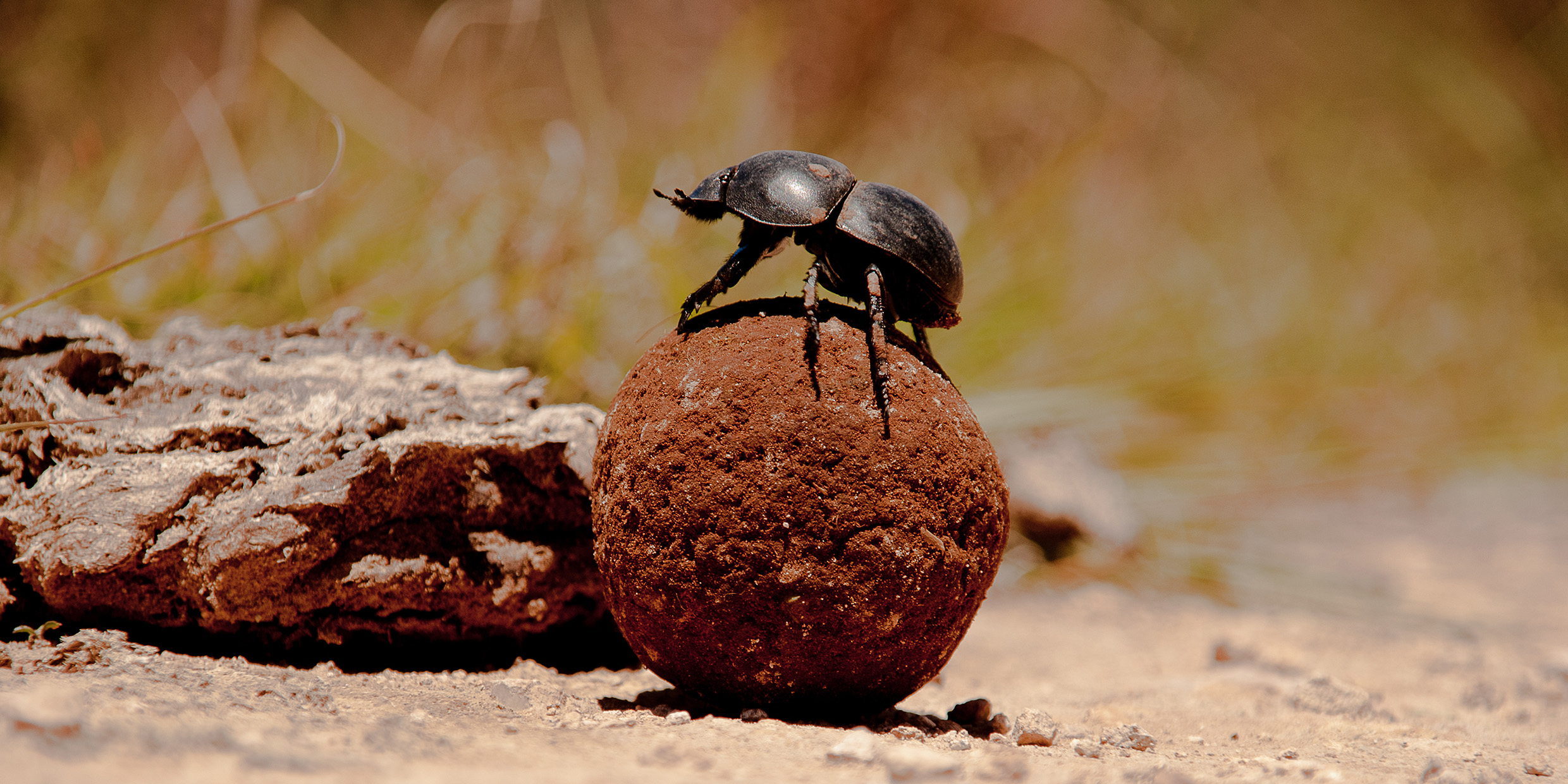Originally published 15 March 1993
A new television commercial contrasts the fun of drinking Pepsi with the boredom of attending college classes. In the classroom sequence, a tweedy professor drones on about “dung beetles.”
Oh, dear. The insects that were venerated as gods by the ancient Egyptians are now made a figure of fun.
Dung beetles deserve better.
But how shall I praise creatures that have such…such distasteful habits? Readers of this column will rightly prefer a less…uh, earthy subject for their breakfast reading fare.
But someone must speak for the dung beetles, or the Pepsi advertising moguls will confine them to ignominy. In this day when recycling is all the rage — indeed, a moral imperative — dung beetles should be venerated again as recyclers par excellence. Without them we would be up to our…
Never mind. Let J. Henri Fabre, the famous turn-of-the-century French entomologist, provide the voice. He spent years studying the lives of these “dealers in ordure.” He filled cages with the insects, and bribed local children with lollipops to bring him heaps of excrement gathered from the fields and roads. And he watched. Watched as the dung beetles cut the excrement into balls, rolled them away, and buried them.
The dung balls serve as food for adult beetles and for larvae. “Out of filth, she creates the flowers,” rhapsodized Fabre about the dung beetle, “from a little manure, she extracts the thrice-blessed grain of wheat.”
The curious ball-rolling habits of these insects evolved tens of millions of years ago. Several entomologists have suggested that hordes of dung beetles followed dinosaurs around, cleaning up behind. It makes perfect evolutionary sense. The mountainous droppings of lumbering dinosaurs were rich in nutrients — an ecological resource not to be wasted. A triceratops plop must have seemed like manna from heaven to the earliest dung-scavenging beetles.
Today, thousands of species of dung beetles clean up after large animals worldwide. They inhabit pastures, paddocks, roadsides, and prairies — any place animals graze. They come in all sizes, from ant-sized beetles that roll pea-sized balls, to beetles bigger than a baby’s hand that cut spheres the size of baseballs from elephant dung.
Male and female beetles harvest ordure. Like Cinderella and her Prince, a pair is likely to meet at the ball. Together, they cut and roll — the female sometimes rides the ball while the male pushes it along with his back legs. When they find a suitable place, the male buries the ball by digging the earth from underneath, and the female sinks along with their treasure. Underground, the pair feeds upon the ball and then mate. It is a quaint nuptial rite, one of nature’s more charming courtships, a fecal fairy tale.
In the days of Rameses and King Tut, Egyptian peasants watched the fat black insects trundle balls of camel dung backwards. They saw in the rolling sphere a perfect image of the sun’s daily roll across the sky, and awarded the dung beetle, or scarab, divine honors as the creature that keeps the celestial spheres in motion. Modern ecologists forego the astronomical metaphors, but are still apt to see dung beetles as no less than divine.
A few years ago, I had the pleasure of reading a new book on Dung Beetle Ecology, published by Princeton University Press, an anthology of the latest research from all over the world (my interest had been peaked by an earlier article on the subject in Scientific American). Much has been learned about these insects since Fabre huddled over his cages watching dung beetles devour whatever supplies of food he was able to purchase with lollipops. Thanks to modern ecologists, we now know the world would be a less felicitous place without these insects.
Dung beetles clean up messes that would choke out plant life upon which grazing animals depend. They fertilize and aerate the soil. They retard the spread of animal parasites, disease organisms, and flies. Dung beetles are nature’s sweeper-uppers.
Some species of dung beetles sneak around during the day to get the drop (so to speak) on their more numerous nocturnal cousins. Ball stealing is also common. Some beetles would rather snatch a ready-made ball than fashion one of their own. Struggles for possession are titanic. Entomologists Bernd Heinrich and George Bartholomew observed certain African beetles roll their prizes away at speeds as fast as 40 feet per minute.
It is inspiring to think of these generations of entomologists, beginning with Fabre, down on their knees, clothespins on their noses, studying the habits of dung-rolling beetles. These days, scientists get government grants to go where elephant dung abounds; the cost of research has gone up since Fabre distributed lollipops. But the goal remains the same: understanding the intricate fabric of life.
So let that fictitious professor in the commercial drone on about dung beetles. For my lollipops, I’d rather hear about the wonderful ecology of these “dealers in ordure” than drink a Pepsi. As J. Henri Fabre had it, “Notwithstanding their disgusting occupation, dung beetles are of a very respectable standing.”



